|
|
 |
|
Calanoida ( Order ) |
|
|
|
Eucalanoidea ( Superfamily ) |
|
|
|
Rhincalanidae ( Family ) |
|
|
|
Rhincalanus ( Genus ) |
|
|
| |
Rhincalanus rostrifrons (Dana, 1849) (F,M) | |
| | | | | | | Syn.: | Calanus rostrifrons Dana,1849;
Rhincalanus cornutus : Brady, 1883 (p.41, figs.F); Giesbrecht, 1892 (part., p.153, Pl.12, figs.13, 15; Pl.35, figs.45, 48); Giesbrecht & Schmeil, 1898 (part., p.23); ? Sewell, 1912 (? part., p.353, 358); Farran, 1929 (part., p.208, 220); ? Farran, 1936 a (p.79); Mori, 1929 (p.171, figs.F,M); 1937 (1964) (p.27, figs.F,M); Wilson, 1942 a (part., p.205); 1950 (part., p.318); ? Krishnaswamy, 1953 (p.112); Tanaka, 1956 (p.271); ? Grice, 1962 (p.181, figs.M, juv.F); ? Mullin, 1966 (p.546, Table I, III, diet); ? Owre & Foyo, 1967 (part., p.37); ? Morris, 1970 (p.2300, 2302); ? Yoo, 1991 (tab.1); ? Shih & Young, 1995 (p.69); ? Noda & al., 1998 (p.55, Table 3, occurrence); ? Yin & al., 2004 (p.3); ? Jang M.-C & al., 2012 (p.37, abundance and seasonal distribution);
Rhincalanus cornutus typica Schmaus, 1917 (p.312); Schmaus & Lehnhofer, 1927 (p.358, 359, 365, figs.F,M, juv.); Tanaka, 1935 (p.152, figs.F, juv.M); Sewell, 1947 (p.48, Rem.); Grice, 1962 (p.182, 183, figs.M); Mazza, 1967 (p.321, fig.64); ? Guangshan & Honglin, 1984 (p.118, tab.) | | | | Ref.: | | | Vervoort, 1946 (p.119, Rem.); Bowman, 1971 b (p.18, Rem.: valid species); Björnberg, 1973 (p.298); Greenwood, 1976 (p.16); Kimmerer & al., 1985 (p.428); Brodsky & al., 1983 (p.201, figs.F,M, Rem.); Bradford-Grieve, 1994 (p.87, figs.F,M); Conway & al., 2003 (p.171, figs.F,M, Rem.); Goetze, 2003 (p.2322 & suiv.); Boxshall & Halsey, 2004 (p.176); Goetze & Ohman, 2010 (p.2110, Table 1, 6, A1, Fig.17, molecular study, biogeography) | 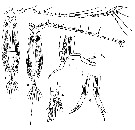 issued from : T. Mori in The pelagic Copepoda from the neighbouring waters of Japan, 1937 (2nd edit., 1964). [Pl.10, Figs.1-5]. As .
Female: 1, habitus (dorsal); 4, P1; 5, P5.
Male: 2, habitus (dorsal); 3, P5.
|
 issued from : T.E. Bowman in Smithson. Contr. Zool., 1971, 96. [p.24, Fig.19, a-b]. Female: a, P5; b, distal segments of A1 (dorsal).
|
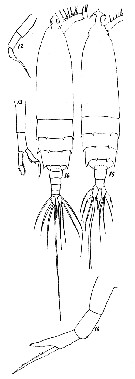 issued from T. Mori in Zool. Mag. Tokyo, 1929, 41 (486-487). [Pl. IV, Figs. 12-16]. As Rhincalanus cornutus. Female (from Chosen Strait, Korea-Japan): 15, habitus (dorsal); 16, P5. Male: 12, right P5; 13, left P5; 14, habitus (dorsal).
|
 issued from : G.D. Grice in Fish. Bull. Fish and Wildl. Ser., 1962, 61. [p.182, Pl.3, Figs.18-19]. As Rhincalanus cornutus. With doubt. Male Juv.5 (from equatorial Pacific): 18, P5. Male: 19, P5. Nota: All the females belong to R. cornutus f typica Schmaus.
|
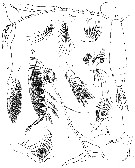 Issued from : G.S. Brady in Rep. Scient. Results Voy. Challenger, Zool., 1883, 8 (23). [Pl. VII]. As Rhincalanus cornutus. Female: 1,habitus (dorsal); 2, habitus (orher specimen; lateral); 3, A2; 4, Md; 5, Mx1; 6, Mx2; 7, Mxp; 8, P1; 9, swimming leg (2nd, 3rd or 4th pair); 10, P5.
|
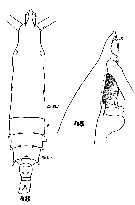 Issued from : W. Giesbrecht in Systematik und Faunistik der Pelagischen Copepoden des Golfes von Neapel und der angrenzenden Meeres-Abschnitte. – Fauna Flora Golf. Neapel, 1892, 19 , Atlas von 54 Tafeln. [Taf.35, Figs.45, 48]. As Rhincalanus cornutus. Female: 45, head (lateral); 48, habitus (dorsal).
|
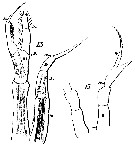 Issued from : W. Giesbrecht in Systematik und Faunistik der Pelagischen Copepoden des Golfes von Neapel und der angrenzenden Meeres-Abschnitte. – Fauna Flora Golf. Neapel, 1892, 19 , Atlas von 54 Tafeln. [Taf.12, Figs.13, 15]. As Rhincalanus cornutus. Male: 13, P5 (anterior surface). Female: 15, P5
|
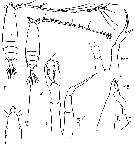 issued from : K.A. Brodsky, N.V. Vyshkvartseva, M.S. Kos & E.L. Markhaseva in Opred. Fauna SSSR., 1983, 1. [p.201, Fig.89]. After Mori, 1937; Giesbrecht, 1892. Female & Male. L: left leg; R: right leg.
|
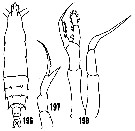 issued from : H.B. Owre & M. Foyo in Fauna Caribaea, 1, Crustacea, 1: Copepoda. Copepods of the Florida Current. 1967. [p.38, Figs.196-198]. As Rhincalanus cornutus, after Giesbrecht, 1892. Female: 196, habitus (dorsal); 197, P5. Nota: Forehead with an elongated projection, rostral filaments visible in dorsal view. P5 without seta on the 2nd segment and with 1 stout external spine on the 3
rd. Male: 198, P5. Nota: P5 terminates in a stout straight seta.
| | | | | Compl. Ref.: | | | Björnberg, 1973 (p.298, 389); Chen Y.-Q., 1986 (p.205, Table 1: abundance %, fig.7, Table 2: vertical distribution); Madhupratap & Haridas, 1986 (p.105, tab.1); 1990 (p.305, fig.6: vertical distribution night/day; fig.7: cluster); Padmavati & al., 1998 (p.349); Hsieh & Chiu, 1998 (tab.2); Smith S. & al., 1998 (p.2369, Table 6, moonsoon effects); Madhupratap & al., 2001 (p. 1345, vertical distribution vs. O2, figs.4, 5: clusters); Lo & al., 2001 (1139, tab.I); Hsieh & al. 2004 (p.397, tab. 1); Chang & Fang, 2004 (p.456, tab.1); Lan & al., 2004 (p.332, tab.1); Gallienne & al., 2004 (p.5, tab.3); Lo & al., 2004 (p.89, tab.1); Fabian & al., 2005 (p.178, fig.4); Prusova & Smith, 2005 (p.76); Zuo & al., 2006 (p.159, tab.1, 3, abundance, fig.8: stations group); Hwang & al., 2006 (p.943, tabl. I); Hwang & al., 2007 (p.24); Dur & al., 2007 (p.197, Table IV); Fernandes, 2008 (p.465, Tabl.2); Tseng L.-C. & al., 2008 (p.153, Table 2, fig.5, occurrence vs geographic distribution, indicator species); Lan Y.C. & al., 2008 (p.61, Table 1, % vs stations); Lan Y.-C. & al., 2009 (p.1, Table 2, % vs hydrogaphic conditions); Cornils & al., 2010 (p.2076, Table 3); Hsiao S.H. & al., 2011 (p.475, Appendix I); Kâ & Hwang, 2011 (p.155, Table 3: occurrence %); Hsiao & al., 2011 (p.317, Table 2, indicator of seasonal change); Cass, 2011 (p.1, oxygen consumption, excretion, composition, metabolism, lipids); Tseng L.-C. & al., 2011 (p.47, Table 2, occurrences vs mesh sizes); Tseng & al., 2012 (p.621, Table 3: abundance); Shimode & al., 2012 (p.133, life history); Tseng & al., 2013 (p.507, seasonal abundance); Hirai & al., 2013 (p.1, Table I, molecular marker); Williams R., 2013 (p.71, Table 3.2, 3.4, 3.6, 3.7, Appendix A, C; C & N composition, trophic level); Hwang & al., 2014 (p.43, Appendix A: seasonal abundance); Jerez-Guerrero & al., 2017 (p.1046, Table 1: temporal occurrence); Hirai & al., 2020 (p.1, Fig. 5: cluster analysis (OTU), spatial distribution). | | | | NZ: | 10 + 3 doubtful | | |
|
Distribution map of Rhincalanus rostrifrons by geographical zones
|
| | | | | | | | | | | |  Isseud from : E. Goetze & M.D. Ohman in Deep-Sea Res. II, 2010 (57). [p.2126, Fig.17]. Isseud from : E. Goetze & M.D. Ohman in Deep-Sea Res. II, 2010 (57). [p.2126, Fig.17].
Biogeographic distribution of two genetic lineages in Rhincalanus rostrifrons.
Lineage 1 is endemic to the eastern tropical Pacific. Lineage 2 occurs rhroughout the Indian Ocean and western Pacific.
The species distribution from Lang (1965) is outlined with hatched lines, and the sample distribution on which it was based is indicated in the legend. |
 Issued from : S. Shimode, K. Takahashi, Y. Shimizu, T. Nonomura & A. Tsuda in Deep-Sea Res. I, 2012, 65. [p.143, Fig.10, b]. Issued from : S. Shimode, K. Takahashi, Y. Shimizu, T. Nonomura & A. Tsuda in Deep-Sea Res. I, 2012, 65. [p.143, Fig.10, b].
Schematic illustration of the most probable life cycle of Rhincalanus rostrifrons (b). Ontogenetic vertical migration during the year in the Kuroshio-Oyashio transition area
C = copepodite stage; AF = female adult; AM = male adult.
Compare with Rhincalanus nasutus widely distributed from 20°N to 49°N in the NW Pacific. |
 Issued from : M. Madhupratap & P. Haridas in J. Plankton Res., 12 (2). [p.313, Fig.6]. Issued from : M. Madhupratap & P. Haridas in J. Plankton Res., 12 (2). [p.313, Fig.6].
Vertical distribution of calanoid copepod (mean +1 SE), abundance No/100 m3. 62- Rhincalanus rostrifrons.
Night: shaded, day: unshaded.
Samples collected from 6 stations located off Cochin (India), SE Arabian Sea, November 1983, with a Multiple Closing Plankton Net (mesh aperture 300 µm), in vertical hauls at 4 depth intervalls (0-200, 200-400, 400-600, 600-1000 m). |
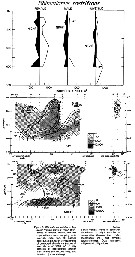 Issued from : Y.-Q. Chen in CalCOFI Rep., 1986, XXVII. [Fig.7, p.215]. Issued from : Y.-Q. Chen in CalCOFI Rep., 1986, XXVII. [Fig.7, p.215].
Vertical abundance of females, males and late copepodites.
Nota: The distribution during the Krill Expedition in the Pacific east tropical (23°N to 3°S) was less abundant than Rhincalanus nasutus, but its distribution was more extensive. In day samples R. rostrifrons occurred mainly beneath 50 m south of 11°N. In general, both females and males were concentrated above 400 m.
The highest densities reached 5000 individuals/1000 m3. The species occurred in lower numbers and at fewer depths at stations 12 and 14.
Diel vertical migration was not apparent.
R. rostrifrons appears to be better adapted to the studied region than R. nasutus.
The mean percentage combined was 1.6% (day: 1.6, night: 1.6) for all samples with the bongo net .
See in Subeucalanus subtenuis figs.1, 12, 13). |
| | | | Loc: | | | ? South Africa (E), NW Atlant., W Medit. (SW Basin), G. of Aden, Arabian Sea, Maldive Is., Madagascar, Mascarene Basin, Rodrigues Is. - Seychelles, ? Natal, equatorial Indian Ocean , India (Lawson's Bay), Madras, Sulu Sea, SW Celebes, NW New-Guinea, China Seas (East China Sea, South China Sea), Taiwan Strait, Taiwan (S, W, SW, Kaohsiung Harbor, NW, N, NE, Kuroshio Current), Korea, Korea Strait, Japan, Kuroshio-Oyashio transition area, off SE Japan, Kuchinoerabu Is., ? Pacif. (central tropical & subarct), ? G. of California, ? G. of Tehuantepec, Australia (? Great Barrier, Moreton Bay, Shark Bay), New Zealand, off W Guatemala, Tehuantepec Bowl - Costa Rica Dome, Bahia Cupica (Colombia), Galapagos, Chile | | | | N: | 58 (?) | | | | Lg.: | | | (125) F: 3,63-3,24; (131) F: 3,8-2,9; M: 2,9-2,4; (991) F: 2,79-3,8; M: 2,41-2,95; {F: 2,79-3,80; M: 2,40-2,95} | | | | Rem.: | Meso-bathypelagic. Confused with R. cornutus. The species R. rostrifrons is Indo-pacific whereas R. cornutus would be restricted to the Atlantic Ocean and the Mediterranean Sea (however Mazza, 1967, reports this form in the Western Mediterranean in the path of Atlantic waters).
See the remark in R. cornutus for the dimensions and the locality records in the Indo Pacific due to authors between brackets.
According to Morris (1970, p.2302) this species (as R. cornutus) is the first record from the subarctic Pacific (49°0,'N, 160°49'W at 0-350 m), the previous most northely record in the Pacific was only 34°N by Marukawa (1908) as R. cornutus.
See in DVP Conway & al., 2003 (version 1) | | | Last update : 09/12/2020 | |
|
|
 Any use of this site for a publication will be mentioned with the following reference : Any use of this site for a publication will be mentioned with the following reference :
Razouls C., Desreumaux N., Kouwenberg J. and de Bovée F., 2005-2025. - Biodiversity of Marine Planktonic Copepods (morphology, geographical distribution and biological data). Sorbonne University, CNRS. Available at http://copepodes.obs-banyuls.fr/en [Accessed December 24, 2025] © copyright 2005-2025 Sorbonne University, CNRS
|
|
 |
 |














